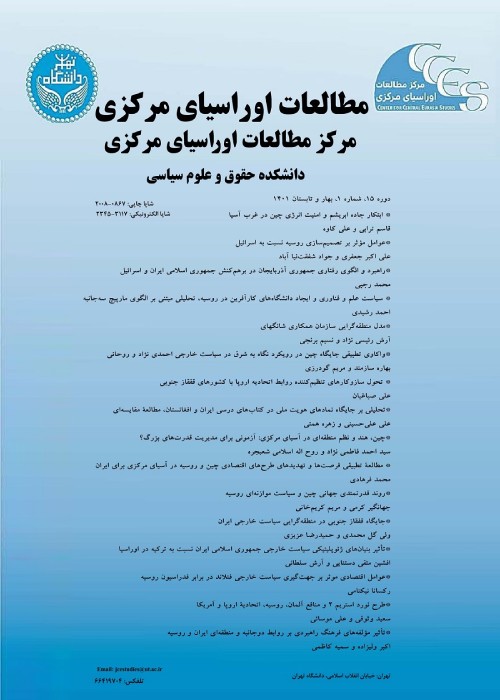The Formation of the Eurasian Economic Union and the Labor Migration from Central Asia to Russia
During the Soviet Union, as a result of accelerated industrialization policies and agricultural expansion, migration flows in Central Eurasia were mainly from the center of the Soviet Union to Central Asia. But at the beginning of the 1990s and after the collapse of Soviet Union, the situation changed. A large number of Russians living in Central Asian republics immigrated to Russia for fear of ethnic discrimination. In addition, due to poverty and unemployment, war (in Tajikistan) and environmental problems, Central Asians migrated to Russia. This is despite the fact that a significant part of the migrations were labor migrations, which were done with the motive of employment and earning money to cover the expenses of the families living in the republics. Even today, due to cultural and linguistic affinities, family ties, ease of travel as well as Russia's strong need for labor in the early 2000s, the large-scale labor migration from Central Asia to Russia is one of the main streams of migration to Russia. To the extent that today, the remittances sent by these immigrants to their countries of origin constitute a significant share of the GDP of the respective countries especially Tajikistan and Kyrgyzstan. Therefore, it can be seen that the migration flow in the region has been reversed after the collapse of the Soviet Union. After the integration of some countries in the region in the form of the Eurasian Economic Union and facilitating the free movement of labor among the member countries, it seems that changes have been made in the migration process from member countries of the Eurasian Economic Union to Russia.
Research question:
In this research, focusing on the migrations to Russia from Central Asian countries, the main question is that: what effects has the formation of the Eurasian Economic Union had on the migration process from Central Asia to Russia? There are also a number of sub-questions, the answers to which can lead us to the answer to the main question. These questions are: What are the characteristics of Central Asian migrations to Russia? And what is the relationship between the economic theory of immigration and economic convergence?
Research hypothesis:
In response to the above question, the hypothesis is examined that " The membership of Kazakhstan, Kyrgyzstan and Russia in the Eurasian Economic Union has increased the process of labor migration from the first two countries to Russia by influencing the costs of migrant workers."
Considering that several factors can be effective in determining the flow of migration from Central Asia, which cannot be controlled, in this article the qualitative method of bivariate correlation is used. In this method, an attempt has been made to evaluate the relationship between the two variables of the formation of the Eurasian Economic Union (independent variable) and the change in migration process from Central Asia (dependent variable) by qualitatively evaluating the available data. Although the effect of variable a on variable B is not measured in this method, the existence of a positive or negative relationship between the two variables is evaluated.
Surveys showed that firstly, most of the migrations from the Central Asian republics are work and temporary migrations, and therefore are carried out by the population of working age. Secondly, the ratio of the number of immigrants to the total population of each republic is higher in poorer countries than in richer regions and countries. Thirdly, migrations often have a male face and are related to unskilled and semi-skilled workers. Fourthly, the establishment of the Eurasian Economic Union has eased the labor migration conditions between the member countries and reduced its costs, and this has affected the flow of labor migration. At the same time, the lack of accurate and reliable statistics, especially regarding the country of Turkmenistan, and the impossibility of assessing the volume of illegal labor migration, were the most important challenges for an accurate assessment of the migration process in the region.Examining the collected data and information and comparing the share of member and non-member countries of the Eurasian Economic Union in the period before and after the establishment of the Eurasian Economic Union in work migration to Russia shows that after the membership of Kazakhstan and Kyrgyzstan, the migration of workers from these two countries to Russia has increased.
In this article, changes in the nature and countries of origin and destination of immigration after the collapse of the Soviet Union were investigated. Studies have shown that, unlike the early years of the collapse, when migrations were ethnic or social in nature, since the early 2000s they have become more economic in nature, and the two countries of Kazakhstan and Russia, became the most important destinations for work migration due to economic growth. Also, the impact of immigration process from member countries and non-member countries in the Eurasian Economic Union was investigated. The comparison of statistics showed that there is a positive correlation between the membership of the republics in this union and the increase of work migrations to Russia. In other words, with the formation of the Eurasian Economic Union, the number of labor migrations from union member countries to Russia has increased compared to non-member countries.
- حق عضویت دریافتی صرف حمایت از نشریات عضو و نگهداری، تکمیل و توسعه مگیران میشود.
- پرداخت حق اشتراک و دانلود مقالات اجازه بازنشر آن در سایر رسانههای چاپی و دیجیتال را به کاربر نمیدهد.


